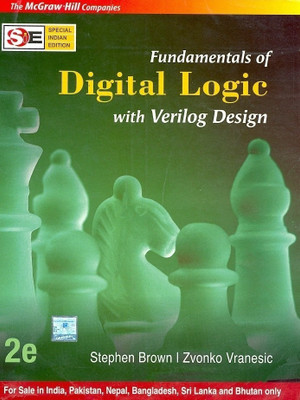Fundamentals of Digital Logic with Verilog Design(English, Paperback, Brown Stephen A.)
Quick Overview
Product Price Comparison
Fundamentals Of Digital Logic With Verilog Design explains the basic concepts of classic manual digital design, and also explains modern day use of CAD tools for designing digital circuits. Summary Of The Book Mainly designed for undergraduate students of Digital Principles and Logic Design, Fundamentals of Digital Logic with Verilog Design strikes a perfect balance between explaining the concepts and illustrating their practical application through CAD tools. A proper understanding of logic circuits, that is, circuits from which computers are built, is vital for todayŌĆÖs computer and electrical engineers. In this book, the authors have given detailed theoretical explanations and have also included several examples to further enhance the studentsŌĆÖ understanding of simple circuit design, using the classic manual method and modern day methods, using CAD tools. There is an emphasis on Programmable Logic Devices, using the most appropriate modern technology, FPGA and CPLD. The use of the IEEE standard Verilog HDL language has also been discussed. The software, Altera Quartus II, is included in this text. This software provides automatic mapping of a design into Altera CPLDs and FPGAs. The book also provides numerous examples of design that can help complement a course. The authors have included 173 solved examples, 687 illustrations and 356 problems. There are 12 chapters in the book. These are Design Concepts, Introduction to Logic Circuits, Optimized Implementation of Logic Functions, Implementation Technology, Combinational-Circuit Building Blocks, Number Representation and Arithmetic Circuits, Synchronous Sequential Circuits, Asynchronous Sequential Circuits, Flip-Flops, Registers, Counters and a Simple Processor, Testing of Logic Circuits, Digital System Design, and Computer Aided Design Tools. Appendix A is Verilog Reference and Appendix B is Commercial Devices. Each chapter begins with a section titled Chapter Objectives, which gives an overview of what the chapter deals with. About The Authors Stephen Brown is a Professor at the Department of Electrical and Computer Engineering, University of Toronto. Brown joined the UniversityŌĆÖs faculty in 1992. Brown has also co-authored Field-Programmable Gate Arrays. Stephen Brown received his Ph.D and M.A.Sc degrees in Electrical Engineering from the University of Toronto. He completed his B.A.Sc degree from the University of New Brunswick. Brown is an Architect at the Altera Toronto Technology Center and is also the Director of the Altera University Program. Brown has received several awards for excellence in teaching computer engineering, electrical engineering and courses in computer science. Brown has also co-authored 60 scientific research papers. Zvonko George Vranesic is the Professor Emeritus in the Department of Electrical and Computer Engineering, University of Toronto. Apart from the two books he co-authored with Brown, he has also written Computer Organization. Born in Zagreb, Croatia, he received his B.A.Sc, M.A.Sc and Ph.D. degrees from the University of Toronto. He joined the same University as a faculty in 1968. Vranesic was a co-founder of Microdesign Ltd., a high technology company, which later became the R&D arm of Meridian Technologies Co. Vranesic is also a Principal Software Engineer at the Altera Toronto Technology Center. Zvonko Vranesic is also a known chess player and has represented Canada in various tournaments. He holds the International Master title. He has over 150 published papers.


